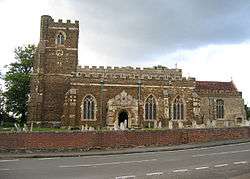Houghton Conquest
| Houghton Conquest | |
 All Saints parish church |
|
 Houghton Conquest |
|
| Population | 1,514 (2011 Census)[1] |
|---|---|
| OS grid reference | TL047416 |
| Unitary authority | Central Bedfordshire |
| Ceremonial county | Bedfordshire |
| Region | East |
| Country | England |
| Sovereign state | United Kingdom |
| Post town | BEDFORD |
| Postcode district | MK45 |
| Dialling code | 01234 |
| Police | Bedfordshire |
| Fire | Bedfordshire and Luton |
| Ambulance | East of England |
| EU Parliament | East of England |
| UK Parliament | Mid Bedfordshire |
|
|
Coordinates: 52°03′47″N 0°28′26″W / 52.06315°N 0.47396°W
Houghton Conquest is a village and civil parish located in the Central Bedfordshire district of Bedfordshire, England. The parish also includes the hamlet of How End.
History
Historically in the hundred of Redbornestoke,[2] the name of the village originated from the Conquest family who held a manor and lands in the area from the 13th century to the 18th century.[3] The Houghton in Houghton Conquest is pronounced how-ton and this has been the official pronunciation since at least 1998.
The Church of All Saints was constructed in the village during the 14th century, and is today the largest parish church in Bedfordshire.[4] Features of interest include the wall paintings, sculpture, stained glass, benches and stalls.[5]
Manors
The Conquest family owned Conquestbury, a large manor which was left to ruin when the family left the area. The Conquestbury manor house stood near the southeast end of the village on the ground now known as Bury Farm, adjacent to London Lane. Parts of the original house were used to build a house in the 1850s, which today serves as a village shop.[6]
Houghton House was also built in the area in approximately 1615. In 1794, Francis Russell, 5th Duke of Bedford stripped Houghton House of its furnishings and removed the roof. Today, the remains of Houghton House stand as ruins.
Geography
The village is located in the northern part of Central Bedfordshire, on the border with the Borough of Bedford. Local amenities include a village shop, post office, Houghton Conquest Lower School, a village hall, and three pubs named "The Knife and Cleaver",[7] "The Royal Oak"[8] and "The Chequers".[9]
References
- ↑ "Civil Parish population 2011". Neighbourhood Statistics. Office for National Statistics. Retrieved 8 November 2016.
- ↑ "Houghton Conquest". GENUKI. Retrieved 2007-06-12.
- ↑ Plea Rolls of the Court of Common Pleas; National Archives; CP 40 / 677; http://aalt.law.uh.edu/AALT1/H6/CP40no677/bCP40no677dorses/IMG_1331.htm; 7th entry; "John Conquest, of Houghton, Beds, gent"
- ↑ "The knife and cleaver bedford pub and guest house". Theknifeandcleaver.co.uk. 2010-06-01. Retrieved 2012-10-13.
- ↑ Jones, Lawrence E. (1965) A Guide to Some Interesting Old English Churches. London: Historic Churches Preservation Trust; p. 9
- ↑ "Parishes - Houghton Conquest | A History of the County of Bedford: Volume 3 (pp. 288-296)". British-history.ac.uk. Retrieved 2012-10-13.
- ↑ "The knife and cleaver bedford pub and guest house". Theknifeandcleaver.co.uk. 2010-06-01. Retrieved 2012-10-13.
- ↑ "Royal Oak, Houghton Conquest - Charles Wells Brewery and Pub Company Bedford". www.charleswells.co.uk. Retrieved 2012-10-13.
- ↑ "The Chequers - Emery Inns".
Additional reading
- Eric Meadows (1975). Pictorial Guide to Bedfordshire. Luton, Bedfordshire: White Crescent Press Ltd. ISBN 0-900804-10-6.
- John William Burgon: Memorandum relating to the parish of Houghton Conquest in Bedfordshire. First published 1903-1904 in the Houghton Conquest Parish Magazine, Edited by Herbert W. Macklin.
External links
| Wikimedia Commons has media related to Houghton Conquest. |